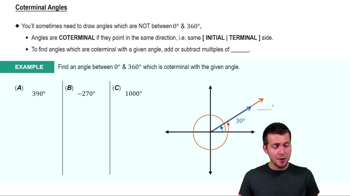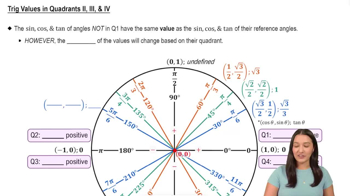Table of contents
- 0. Review of College Algebra4h 43m
- 1. Measuring Angles39m
- 2. Trigonometric Functions on Right Triangles2h 5m
- 3. Unit Circle1h 19m
- 4. Graphing Trigonometric Functions1h 19m
- 5. Inverse Trigonometric Functions and Basic Trigonometric Equations1h 41m
- 6. Trigonometric Identities and More Equations2h 34m
- 7. Non-Right Triangles1h 38m
- 8. Vectors2h 25m
- 9. Polar Equations2h 5m
- 10. Parametric Equations1h 6m
- 11. Graphing Complex Numbers1h 7m
3. Unit Circle
Reference Angles
Problem 75
Textbook Question
Textbook QuestionIn Exercises 61–86, use reference angles to find the exact value of each expression. Do not use a calculator. tan(-𝜋/4)
 Verified Solution
Verified SolutionThis video solution was recommended by our tutors as helpful for the problem above
Video duration:
5mPlay a video:
Was this helpful?
Key Concepts
Here are the essential concepts you must grasp in order to answer the question correctly.
Reference Angles
A reference angle is the acute angle formed by the terminal side of an angle in standard position and the x-axis. It is always positive and helps in determining the values of trigonometric functions for angles greater than 90 degrees or negative angles. For example, the reference angle for -π/4 is π/4, which is 45 degrees.
Recommended video:

Reference Angles on the Unit Circle
Tangent Function
The tangent function, defined as the ratio of the opposite side to the adjacent side in a right triangle, can also be expressed as tan(θ) = sin(θ)/cos(θ). The tangent function is periodic with a period of π, meaning tan(θ) = tan(θ + nπ) for any integer n. This property is useful for finding the tangent of negative angles.
Recommended video:

Introduction to Tangent Graph
Negative Angles
Negative angles are measured in the clockwise direction from the positive x-axis. The tangent of a negative angle can be found using the identity tan(-θ) = -tan(θ). This means that to find tan(-π/4), we can use the reference angle π/4 and apply the negative sign, leading to the conclusion that tan(-π/4) = -tan(π/4).
Recommended video:

Coterminal Angles

 5:31m
5:31mWatch next
Master Reference Angles on the Unit Circle with a bite sized video explanation from Callie Rethman
Start learningRelated Videos
Related Practice






















